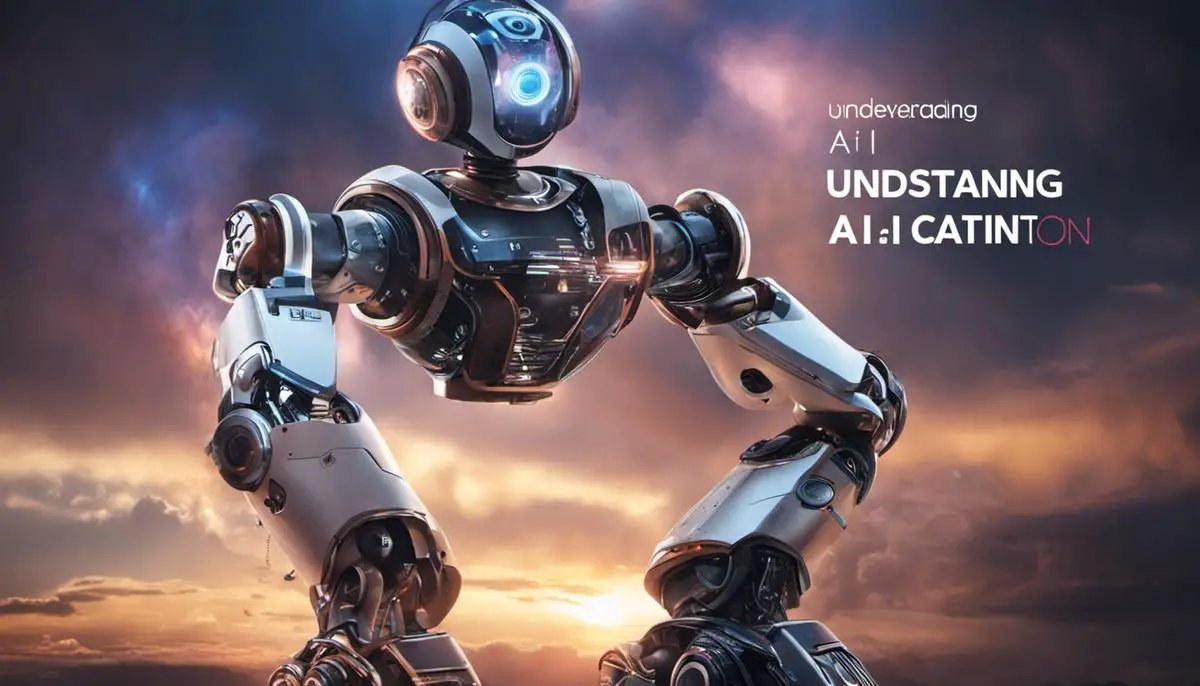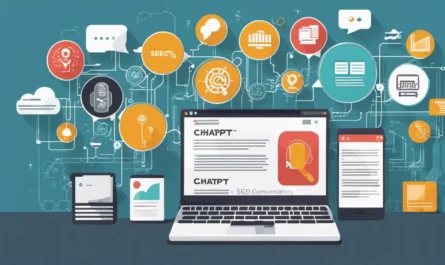As we march ahead into the 21st century, technological advancements define our lives more than ever before, and artificial intelligence (AI) stands at the helm of this revolution. In the realm of content creation, AI’s meteoric rise is neat, nuanced, and nothing short of extraordinary. The integration of AI in content creation introduces an array of possibilities and challenges, simultaneously redefining how information is produced, disseminated, and consumed. This dive into the intersection of AI and content creation explores everything from the historical context and the potential benefits to challenges and popular tools, while also forecasting what lies ahead in the ever-evolving landscape of AI-driven content generation.
Understanding AI and its Role in Content Creation

Understanding Artificial Intelligence
Artificial Intelligence (AI) is a branch of computer science dedicated to creating intelligent machines that work and respond like humans. These machines are designed to mimic human intelligence, performing tasks such as learning, problem-solving, speech recognition, and language translation. AI can be categorized into two main types: Narrow AI, which is designed to perform a narrow task such as voice commands, and General AI, which can understand, learn, and perform any intellectual task that a human being can.
Evolution of AI
In its infancy, AI was primarily used for tasks like problem-solving and symbolic methods. The 1980s marked the advent of machine learning, where AI was taught to learn from data. While machine learning still required human intervention to decipher the patterns in the data, the 2010s introduced deep learning, which enabled AI machines to learn and interpret data independently.
AI in Content Creation
Advancements in AI technology have penetrated various sectors, including content creation. AI-powered systems such as GPT-3 and OpenAI can generate human-like text by predicting the following words in a sentence – producing anything from essays to poems to full-length articles.
Applications of AI in Content Creation
In content creation, AI applications range from simple grammar checkers to complex content generators. Besides content generation, AI also assists in content curation, personalization, and automation. For example, AI can gather data about a reader’s preferences and curate content tailored to their interests, enhancing user engagement. Furthermore, AI chatbots can provide immediate, automated responses to customers, ensuring prompt and efficient customer service.
AI-Driven Content Examples
Market leaders such as Forbes and The Associated Press employ AI for content creation. Forbes uses an AI tool called ‘Bertie’ to assist its writers in creating rough drafts and story templates. The Associated Press, on the other hand, utilizes an AI software called ‘Wordsmith’ to churn out thousands of news stories about earnings reports within a fraction of a second.
BBC news also utilizes AI to automatically assemble prewritten segments of content to produce news articles. CNN leveraged the capabilities of AI for a project called ‘Project Magic,’ which uses AI to turn written content into videos.
AI’s Contribution to Revolutionizing Content Creation
In today’s digital world, content creators often grapple with the task of maintaining quality while generating content consistently. Here, AI comes as a rescuer, offering innovative tools to streamline the content creation process and custom tailor content for the intended audience. When leveraged in content creation, AI not only epitomises swiftness and efficiency, but it also boosts creativity by providing unique input from data interpretation. This results in the efficient delivery of engaging content specific to the audience’s needs, significantly enhancing reader interaction and satisfaction.
Impact and Benefits of AI in Content Creation

AI’s Emergence in Content Creation
With its myriad of benefits, AI is rapidly making its mark in content creation. These high-tech tools, backed by intricate algorithms, are proficient at crafting high-quality customized content swiftly, making them an increasingly desirable option across various industries.
Personalized Content the AI Way
One of the key benefits of AI in content creation is its ability to provide personalized content. To elaborate, AI has the capacity to sift through vast amounts of user data – encompassing user interactions, behavior patterns, preferences, and more – and utilize this insight to create content that appeals intimately to the user. Details that might get overlooked by a human are identified and acted upon by AI, resulting in content that more deeply resonates with its target audience.
Enhancement in Productivity
AI also has transformative implications for productivity levels in content creation. A program equipped with AI capabilities can exponentially increase the speed at which content is produced, while simultaneously minimizing errors. Thus, tasks that would have taken a human employee a considerable amount of time to complete can be executed effortlessly by AI in fractions of the same duration.
Revolutionizing Creativity
AI in content creation does not undermine human creativity; paradoxically, it enhances it. The technology provides creators with analytical insights, thereby freeing up more room and time for creativity. In this way, creators are able to focus on brainstorming and innovative ideation, while AI handles more routine tasks, such as data analysis and pattern identification. This symbiosis between human creators and AI technology results in a plethora of novel and inventive content.
Minimizing Human Error and Effort
AI in content creation also helps in significantly reducing the risk of human error, thereby resulting in workflows that are more streamlined and outputs that are more accurate. AI can handle sophisticated tasks with minimal chances of malfunction, thereby eliminating errors that might slip through in conventional approaches. Moreover, these advanced software programs have the ability to proofread content, correct grammatical and spelling mistakes, and optimize readability to produce polished, professional content.
As we look towards the rapidly evolving future, one can’t deny the potential of AI, especially when it comes to content creation. With capabilities such as analysis, prediction, and creation, AI is set to transform the way we produce content. Through enhanced productivity and creativity, personalization, and error minimization, AI offers the prospect of reducing human effort in the content creation process. The future undoubtedly holds a significant place for the application of AI in content creation.
Challenges and Limitations of AI in Content Creation

The Obstacles of Employing AI in Content Creation
On the flip side of the coin, the adoption of AI for content creation does present several challenges. The most looming among these is the question of retaining the human touch in AI-constructed content. Though AI can undoubtedly churn out content with remarkable speed and efficiency, its prowess in capturing the fine subtleties and nuances that characterize human communication remains questionable. This might translate into content that scores high on technical accuracy but falls short on emotional depth and richness. To draw a parallel, an AI-written story might have perfect grammar and structure but still miss out on the technical nuances, layered emotional depth, and intricate character development that a human author can weave into a novel.
Contextual Understanding in AI Content Creation
AI struggles with properly understanding context and achieves an emotional match. Context is a crucial aspect of any communication. Each sentence we write, read, or speak has a certain context – a surrounding environment, a set of circumstances, a particular meaning. However, understanding and interpreting this context is a complex task, even for AI. While AI can analyze text data and identify patterns within it, comprehending the underlying context poses a challenge. As a result, the content generated by AI can sometimes come across as disjointed or out of context.
Ethical Considerations in AI Content Creation
Ethics is a principal concern in AI content creation. An AI does not have a moral compass, leading to potential problems such as bias, discrimination, inaccuracy, or manipulation. For instance, AI could produce misleading information or false news, especially if the algorithm’s data set includes biased, inaccurate, or manipulated information. Further, AI-generated content runs the risk of infringing upon copyright laws and moral rights. For example, if AI created a piece of work strikingly similar to an original work by a human author, this raises questions about the ownership and originality of AI-generated content.
Necessity of Human Touch in AI-driven Content Creation
AI’s role in content creation, although promising, is subject to some constraints. It requires a human touch. Although artificial intelligence can aid in numerous components of content creation, including data analysis, future trends estimation, and even the creation of original content drafts, the value of human creators cannot be understated. They bring a unique concoction of innovation, emotional perceptiveness, context awareness, and moral judgment that are beyond the reach of AI at present. In the foreseeable future, AI’s role in content creation will predominantly be a supportive one, enhancing human innovation and expertise rather than replacing it.
Popular AI Tools and Platforms for Content Creation

A Broad Look at AI Deployment in Content Creation Tools and Platforms
The emergence of sophisticated AI has largely spearheaded the evolution in the content creation realm, evident in the launching of potent AI tools and platforms. Through the employment of machine learning algorithms and natural language processing mechanics, they generate content that often demands much time and effort to manually produce. Irrespective of their varied methodologies, these tools are congruent in one shared mission: they aim to aid human content creators in fabricating superior quality and engaging content with heightened efficiency.
Articoolo
Articoolo is a web-based artificial intelligence engine designed specifically for content writing. This platform’s primary function is to generate unique textual content based on the user’s specifications. It uses Natural Language Generation (NLG), an AI technology that is capable of turning data into text that has human-like quality. One of Articoolo’s strengths includes the ability to create content swiftly, which can save users a significant amount of time. On the downside, the generated content may sometimes require proofreading and editing to ensure quality and coherence.
Quill
Quill is another prominent artificial intelligence platform driven by Advanced Natural Language Generation (ANLG). Developed by Narrative Science, Quill focuses on transforming raw data into insightful narratives. It is also instrumental in finance and media industries by converting complex data sets into easy-to-understand reports, descriptions, and narratives. While Quill aids in making sense of complex data, it may not fit content needs that require substantial creativity.
Phrasee
Phrasee is a unique AI tool that focuses on optimizing language for marketing purposes. It uses machine learning to automatically generate and optimize email subject lines, push notifications, and social media ads. It learns from previous marketing campaigns to understand what language leads to the best customer engagement. Phrasee’s strength lies in its ability to generate high-performing marketing copy in seconds, but it may not be suitable for businesses looking to tailor their message to a specific audience due to its automated nature.
WordAi
WordAi uses artificial intelligence to understand the text’s context and meaning, allowing it to create human-like text automatically. It can rephrase a block of text while retaining the original meaning, which can be extremely useful for creating unique content. However, like some AI tools, it may occasionally require human oversight and editing to ensure quality.
GPT-2 and GPT-3 by OpenAI
GPT-2 and its successor GPT-3 are powerful AI models developed by OpenAI. They use a type of AI called Transformers, which can generate text that is nearly indistinguishable from those written by humans. These AIs can write complex narratives and even poetry. However, these models require a substantial amount of computational power, and accessing them can be expensive.
When considering the formidable capabilities of AI tools and platforms in revolutionizing content production and marketing strategies, it’s obvious that they bring something invaluable to the table. That said, they also present their own set of challenges. As we understand the advantages and potential drawbacks of these AI tools, we can smartly leverage them to suit our unique needs in content creation. By integrating AI assistance skillfully into our strategies, we can optimize efficiency without losing the human touch that lends authenticity and relatability to our content.
The Future of AI in Content Creation

Merging AI with Content Creation
We are witnessing a drastic shift in content creation procedures, steered fervently by the advent of Artificial Intelligence (AI). AI is dramatically reshaping the way we approach content creation, management, and consumption, offering a plethora of solutions that automate and streamline the work of content creators.
AI proves its mettle in automating high-volume, data-heavy content categories- digital advertisements, social media publications, and news reports, to name a few. Consider natural language generation, an AI technology that crafts easily understandable content like weather updates and financial summaries by processing enormous piles of data.
Machine learning algorithms, with their ability to comprehend content preferences, style, and tone, pave the way for personalized content. These smart algorithms can expertly track user behavior and predict preferences, thus enabling personalized content suggestions and tailored advertising.
Potential Future Trends in AI-Driven Content Creation
Advancements in AI are predicted to lead to efforts in making the technology more human-like. This includes advancing the capabilities of natural language processing, improving story-telling abilities, and enhancing the emotional intelligence of AI.
Emotionally intelligent AI might soon be utilized to create multi-media content tailored to evoke specific emotional responses from targeted audiences. For example, movie scripts and plots might be created using AI that can stimulate specific sentiments in the viewers.
One potential future trend could be an increase in the use of AI-powered tools in journalism, lighting the way to automated journalism. AI algorithms are already capable of writing news reports and articles in seconds that usually take humans hours to write.
Another future trend might be the use of AI algorithms to find patterns and themes within large sets of data, providing storytellers with unique, new perspectives and insights. For example, AI could take a variety of data points about a specific issue or topic, analyze it, and produce a narrative that brings new clarity.
Potential Advantages and Challenges
The benefits of AI in content creation include the ability to handle massive data, speed in creating content, cost-effectiveness, and personalization. The precision and speed of AI can also reduce human error, contributing to the increased quality of the content.
However, the integration of AI in content creation does not come without its challenges. One possible disadvantage is people becoming overly dependent on technology for creativity, in turn, stifling human innovation.
Another potential challenge relates to the ethical and moral concerns of using AI. The question of who is responsible and may be held liable for the content generated by AI remains ambiguous.
Finally, the issue of homogeneity is a significant concern. Since AI algorithms learn from existing data, there is a possibility that they may contribute to a homogenization of content, overriding individual creativity and unique storytelling methods.
As we progress further into the AI-driven era of content creation, it’s important to strike a balance between leveraging AI capabilities and nurturing human creativity. This way, we can utilize AI technology to its fullest potential in content creation, while ensuring varied and unique narratives continue to flourish.
Video: AI Content Creation: 4 Easy Tools to Speed up Your Creative Process
Final Thoughts About AI In Content Creation

The future is ripe with countless possibilities, especially where AI intersects with content creation. As we navigate ahead, there is certain to be a delicate balancing act between leveraging the efficiencies of AI and maintaining the nuanced human element essential to authentic and meaningful connection. Our journey forward will invariably include innovative tools, uncharted benefits, and unforeseen challenges. However, one thing is certain, as AI continues to evolve in impressive new ways, it will undoubtedly continue to revolutionize the world of content creation – reshaping, reimaging, and redefining the ways we communicate, engage, and consume information in the process.
Writio: The AI content writer
for publishers and blogs.
This article was created by Writio.




